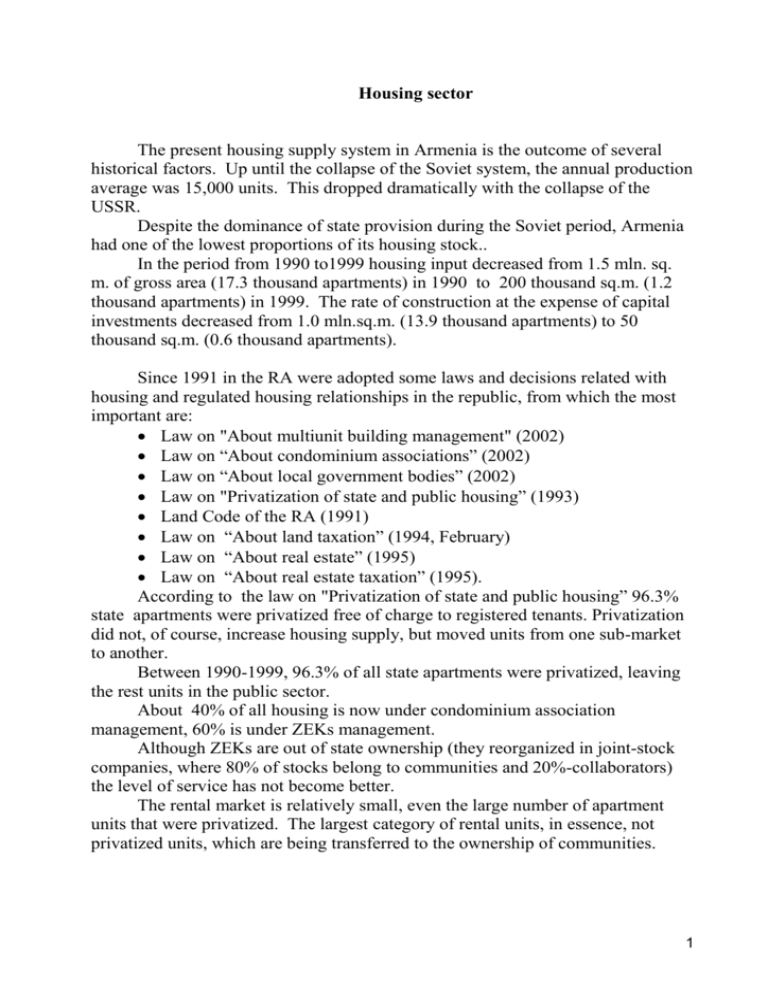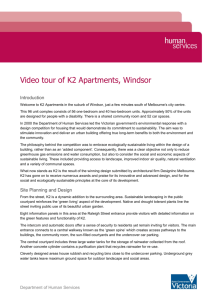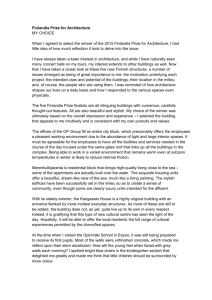Housing Situation in Armenia and Housing Provision in Earthquake
advertisement

Housing sector The present housing supply system in Armenia is the outcome of several historical factors. Up until the collapse of the Soviet system, the annual production average was 15,000 units. This dropped dramatically with the collapse of the USSR. Despite the dominance of state provision during the Soviet period, Armenia had one of the lowest proportions of its housing stock.. In the period from 1990 to1999 housing input decreased from 1.5 mln. sq. m. of gross area (17.3 thousand apartments) in 1990 to 200 thousand sq.m. (1.2 thousand apartments) in 1999. The rate of construction at the expense of capital investments decreased from 1.0 mln.sq.m. (13.9 thousand apartments) to 50 thousand sq.m. (0.6 thousand apartments). Since 1991 in the RA were adopted some laws and decisions related with housing and regulated housing relationships in the republic, from which the most important are: Law on "About multiunit building management" (2002) Law on “About condominium associations” (2002) Law on “About local government bodies” (2002) Law on "Privatization of state and public housing” (1993) Land Code of the RA (1991) Law on “About land taxation” (1994, February) Law on “About real estate” (1995) Law on “About real estate taxation” (1995). According to the law on "Privatization of state and public housing” 96.3% state apartments were privatized free of charge to registered tenants. Privatization did not, of course, increase housing supply, but moved units from one sub-market to another. Between 1990-1999, 96.3% of all state apartments were privatized, leaving the rest units in the public sector. About 40% of all housing is now under condominium association management, 60% is under ZEKs management. Although ZEKs are out of state ownership (they reorganized in joint-stock companies, where 80% of stocks belong to communities and 20%-collaborators) the level of service has not become better. The rental market is relatively small, even the large number of apartment units that were privatized. The largest category of rental units, in essence, not privatized units, which are being transferred to the ownership of communities. 1 Damaged buildings There are 420 (16800 apartments) III category damaged buildings in Armenia now. The calculation shows that these building reconstruction costs about $ 100 mln . These buildings exploitation aggravating, without reconstruction, leads to further constructive elements deterioration and deformation. On one hand according to the laws on "About multiunit building management" and "About condominium association" the tenants have to take care about their building maintenance by their means on the other hand there are a lot of vulnerable families live in these buildings. We would like to have a decision of the problem from the specialists. Incomplete buildings As a result of the Soviet Union collapse and the subsequent creation of the independent Republic of Armenia, a number of buildings were left uncompleted. In present time number of incomplete construction are 4,110 buildings (25 thousand apartments), of which 1,220 are multiunit buildings, 2,890 are cottage type houses. From total amount incomplete residential buildings 3,570 or 87% are in the earthquake zone. 97% of incomplete multiunit residential buildings have level of readiness less than 60% and construction termination of these buildings at the expense of state means economically is not worthy. In accordance with the conducting housing policy further use of incomplete residential buildings, in the framework of state programs (except earthquake zone restoration program) foreseen: to complete those multiunit buildings for completion of which is necessary investment not more than average market cost for 1 sq.m.; sell or write off incomplete multiunit residential buildings (except residential buildings comprised in the earthquake zone restoration program) and cottage type houses, where no citizen registered, in accordance with determined rules. Multiunit buildings maintenance Along with the housing privatization in the beginning of 90th state subsidies for housing maintenance and repair were gradually cutting down. Since 1996 given subsidies totally ceased. The Government of Armenia recently adopted standards that necessary for multiunit building maintenance. Calculation shows that current repair expenses are 2 average $1 for a household monthly. The calculation has been done taking in account population low income and minimal demands for building repair. The standards do not contain calculation for structural repair of multiunit building and each building has to calculate emanate from the individual condition of the building. Except these expenses tenants pay utility payments. For 4 persons average size family these payments, that includes water supply, gas, heating, electricity are about $30, when family average income is $90. In these social-economic circumstances the most owners do not have opportunity to pay whole value of housing maintenance and repair, as a result of that every year cutting down implemented works volume, accumulated buildings wear and arise necessity of substantial investments for putting housing in order from technical point of view. Building maintenance problem decision we see in condominium association development, state support in structural repair, giving housing allowance for vulnerable population. It is necessary to create some mechanisms for establishing housing allowance for housing maintenance and utility service payment. Refugees housing problems From 1988 to 1992 as a result of international relationship aggravation 400 thousand Armenians, who lived in Azerbaijan, forced to come in Armenia. Some of them purchased houses, some went away from the country and some of them the state provided with apartments. Until now refugees housing problems solved at the expense of state means and the German and Norwegian Governments and the UNHCR (the last organizations help about providing permanent housing to 3 thousand families). In spite of that, about 12 thousand families housing problems are not decided. The decision of the problem is financially very expensive for the Government of Armenia. We would like to see the decision in the country profile on the housing sector, taking in account the housing situation in Armenia. Waiting lists As of January 1, 1998, there were 102,000 families on the waiting list for Armenia, 41,000 of them in Yerevan. more than 2.5% of the waiting list can be accommodated in any given year (as has been the case since 1993). What qualifies a family to be placed on a waiting list is less that 5 sq.m. of living space per person in an apartment. The Government has not assisted this families last 7 years. The mortgage loan system works in Armenia only in the center of Yerevan where apartments very expensive. 3 The State obligations and the ways of their solution. The State obligations to population in accordance with housing policy conducting in the Republic : homeless as a result of Spitak earthquake in 1988 (about 12 thousand families) and Noemberyan earthquake in 1997 (1 thousand families) people who live in state damaged multiunit buildings (that could not be privatized) that have to be destroyed (about 743 families -excluding earthquake zone) people who live in damaged by the war buildings in border territories (priority needy about 466 families) people who deprived their houses because of landslide (about 200 families) people deprived their houses because of land allotment for state or community needs (about 186 families) people who live in the third category damaged buildings (about 16800 families) refugees housing problem decision (12 thousand families). According to the calculation for realization of a program for providing housing to these categories of population necessary to construct about 30-35 thousand apartments or approximately 2-2.5 mln.sq.m. gross area of housing, investment in housing construction is about 600 mln. dollar. In present social-economical conditions is needed dozen years. New approaches have to be used related to the present situation for using limited state means directed to housing. Existing disproportion in housing stipulated by high housing supply in the market (9:1), with cost three times less than new construction cost (1sq. meter of gross area of housing on the market averages $80-90 but the same for new construction is $250), new construction state finance participation is not worth while. It is necessary to reorient direct construction financing to free of charge immediate financial aid to citizens for housing acquisition (construction, rent, purchase). It gives citizens opportunity to chose their house place and quality and lets: to make faster housing problem decision to avoid freezing of incomplete buildings funds to stimulate republic real estate market activity. 4 In the middle term future intends implementation aimed financial support to vulnerable families for housing problems decision through giving them housing allowances for housing rent. Housing allowance system will be connected with acting in the Republic family allowance, the main criteria of which is family income and lack of suitable permanent housing. Priorities The main tasks arisen to the RA Government in housing sphere are: 1. Citizens ( deprived of housing because of the earthquake, war, emergency buildings and so on) 2. Housing management effective system development (capital repair fund and condominium associations activity stimulation) 3. Legislation field improvement (rent legislation, housing allowance system). 5









